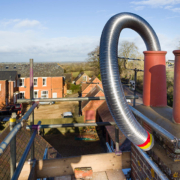What Is a Chimney Liner and Why Does It Matter for Tulsa Homes?
If you live in one of Tulsa’s charming older homes or even a newer build with a working fireplace, your chimney probably isn’t something you think about every day. You light a cozy fire, enjoy the warmth, and don’t give much thought to the mechanics behind it all. But there’s one hidden component inside your chimney that plays a major role in keeping your home safe and efficient the chimney liner. And if you’re a homeowner in Tulsa, understanding the importance of this often-overlooked part of your fireplace system can save you from bigger problems down the road. Let’s break it down, and by the end, you’ll know exactly why you need to keep an eye on your Chimney Liner.
So, What Exactly Is a Chimney Liner?
A chimney liner is basically the inner lining of your chimney flue. It might sound simple, but this lining is crucial. Whether made of clay tiles, stainless steel, or a cast-in-place material, its job is to protect your home in three key ways: by preventing heat from escaping to nearby wood framing, guarding the brickwork against the damaging effects of combustion byproducts, and helping smoke and gases travel up and out of your home smoothly. Without a proper liner or with a damaged one you’re exposing your home to potential fires, toxic gases like carbon monoxide, and expensive structural damage. That’s why it’s a core feature of chimney safety in Tulsa and beyond.
How Do I Know If I Even Have a Chimney Liner?
Good question. If your home was built before the 1940s, there’s a fair chance it either doesn’t have a liner at all or has an old clay tile version that’s started to crack. Modern homes typically come with liners built in, but even those can wear down over time. You won’t be able to spot it just by looking at the outside of your chimney, so it’s always best to schedule a chimney inspection to find out. Here’s a quick table showing liner types and how they compare:
| Liner Type | Material | Lifespan | Best For | Approx. Cost |
| Clay Tile | Terracotta | 30–50 years | Masonry fireplaces | $2,000–$4,000 |
| Stainless Steel | Flexible or rigid metal | 15–25 years | Wood, gas, or oil appliances | $2,500–$5,000 |
| Cast-in-Place | Cement-like slurry | 50+ years | Reinforcing old chimneys | $4,000–$7,000 |
Why It Really Matters for Tulsa Homes
Let’s talk local. Tulsa weather can be unpredictable cold snaps in winter and hot, humid summers. These conditions, paired with the freeze-thaw cycle, can cause masonry chimneys to deteriorate over time. And if your chimney liner isn’t in top shape, that damage gets worse fast. From a safety standpoint, a cracked or missing liner can let hot gases seep into walls or attic space, creating a serious fire risk. It also affects efficiency. A good liner helps your stove or fireplace vent more effectively, which means better heat and fewer drafts. In short, investing in a quality liner isn’t just about maintenance it’s about protecting your family and your home. As one local chimney tech puts it:
“You’d be surprised how many Tulsa homeowners don’t even know what a chimney liner is until a routine inspection catches a crack that could’ve turned dangerous.” — Jake L., Chimney Professional in Tulsa
Key Features You Shouldn’t Ignore: Safety and Cost
Let’s be honest: nobody gets excited about chimney maintenance. But when it comes to your chimney liner, the safety implications alone are worth the attention. It keeps flames and heat inside where they belong and helps channel out harmful gases. That’s peace of mind you can’t put a price tag on. As for the cost? Yes, liner installation or upgrades aren’t cheap, but they’re way less expensive than repairing fire damage or replacing an entire chimney system. Plus, a high-quality liner can increase your home’s resale value and reduce your heating bills over time.
FAQs About Chimney Liners in Tulsa
Q: Can I see the chimney liner myself?
A: Not really. It’s tucked inside the flue, so you’ll need a chimney pro with a camera to assess its condition.
Q: How often should I replace my chimney liner?
A: It depends on the material. Clay tile may last decades but can crack with age. Stainless steel may need replacement after 15–25 years.
Q: Will a new liner make my fireplace more efficient?
A: Yes! A properly sized and installed liner improves airflow and combustion, which means better performance and less creosote buildup.
Q: Is chimney liner work DIY-friendly?
A: Not at all. Installation requires precision and knowledge of building codes. Always hire a certified chimney technician.
Q: Does insurance cover chimney liner replacement?
A: Sometimes, if it’s due to a covered event like a chimney fire. Check with your insurance provider to be sure.
Conclusion: Your Tulsa Chimney Deserves Better
If your home in Tulsa has a chimney, then it deserves a reliable chimney liner. Whether you’re trying to make your fireplace more efficient, boost safety, or simply take care of your property like a pro, understanding your liner and upgrading it when needed is a big step in the right direction. Don’t wait for a smoky room or a scary creosote buildup to take action. Schedule an inspection, ask the right questions, and protect your home from the inside out. After all, it’s not just a liner, it’s your home’s silent guardian.
Read More: Chimney Sweep









Leave a Reply
Want to join the discussion?Feel free to contribute!